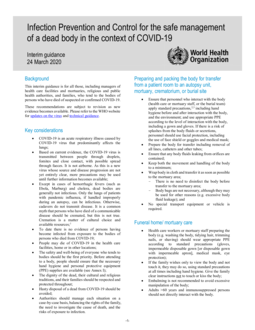Hello! You're looking at a policy document report on Overton
We track government policy, guidelines, think tank research, working papers and more to help our customers see the impact and influence of their work. Are you interested in seeing what information we have to offer? Request a free trial to our platform.
If you fund, produce or manage research or work to influence policy, we'd love to talk. Learn more on our homepage.

Identifiers
Overton ID
who-059f1dae5b7407899e293cb22ca8df21
Infection prevention and control for the safe management of a dead body in the context of COVID-19: interim guidance, 24 March 2020
Topics in this document
Disease
Autopsy
Influenza
Funeral
Health
Coronavirus disease 2019
Medicine
Medical specialties
Public health
Health sciences
Clinical medicine
Bleach
Personal protective equipment
Infection control
Hygiene
Hand washing
Burial
Infection
Disinfectant
Universal precautions
Ebola virus disease
Respirator
Laundry
Pandemic
Influenza pandemic
Virus
Epidemiology
Diseases and disorders
Medical humanities
Related SDGs
SDG 3: Good Health and Well-being ...
SDG 3: Good Health and Well-being
Target 3.d
Strengthen the capacity of all countries, in particular developing countries, for early warning, risk reduction and management of national and global health risk
Citations
Cited by 62
other policy documents
(45 of them are from other policy sources)
